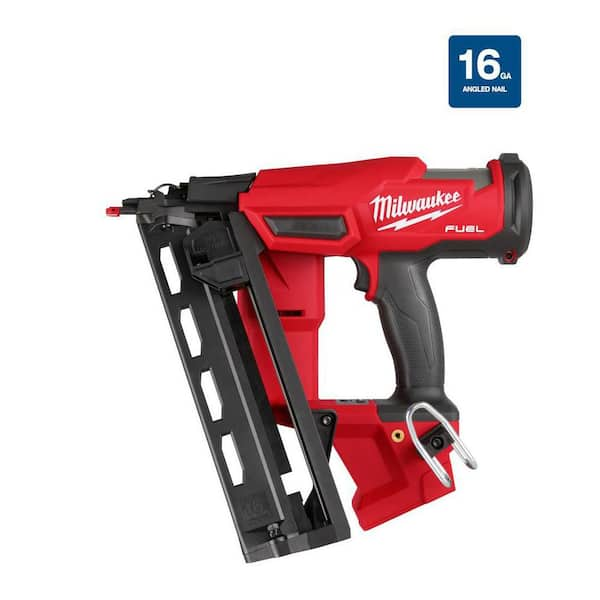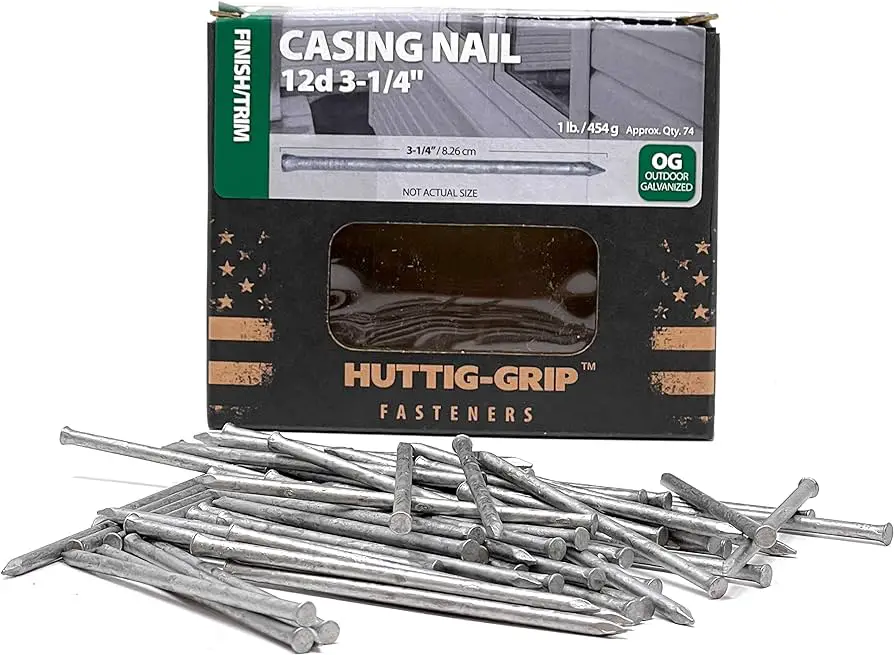A 15 or 16-gauge finish nailer is ideal for installing baseboards due to its compatibility and strength. It provides clean and secure attachment for baseboards, ensuring a professional finish to your project.
When choosing the right finish nailer for baseboards, consider the thickness and material of the baseboards, as well as the type of project you’re working on. Investing in a quality finish nailer can make the installation process smooth and efficient, saving you time and effort in the long run.
By using the appropriate size finish nailer, you can achieve a seamless and polished look for your baseboards that will enhance the overall aesthetics of your space.

Credit: www.homedepot.com
Choosing The Right Finish Nailer
When selecting a finish nailer for baseboards, it’s crucial to choose the right size for optimal results. Understanding the factors that affect your choice can help in making an informed decision.
Considerations For Baseboards
- Trim Size: Match the nailer size to the thickness of your baseboards.
- Material: Ensure the nailer is compatible with the baseboard material (wood, MDF, etc.).
- Usage: Consider if you will be working on multiple projects or mainly baseboards.
Understanding Nail Gauge
- Gauge: Opt for 15- or 16-gauge nails for baseboards for a balance of strength and minimal visibility.
- Brads vs. Finish Nails: Brads are thinner and more discreet but may lack the holding power of finish nails.
By considering these factors and understanding nail gauge, you can confidently choose the right finish nailer for your baseboard projects.

Credit: www.homedepot.com
Ideal Size For Baseboards
For baseboards, the ideal size for a finish nailer would be 15-gauge or 16-gauge. These nailers are perfect for attaching baseboards securely without leaving large holes that need excessive filling. Choosing the right size finish nailer is crucial for achieving a professional-looking finish on your baseboards.
Length Of Nails
Suitable Nail Size For Baseboards
Baseboards play a vital role in enhancing the aesthetics of a room. Choosing the right size finish nailer for baseboards is crucial for achieving a professional and polished look.
Length Of Nails
When it comes to baseboards, the length of nails used for installation is a key consideration. Optimal nails length for baseboards can ensure a secure and seamless attachment.
| Baseboard Thickness | Ideal Nail Length |
|---|---|
| 1/2 inch | 1-1/4 inch nails |
| 3/4 inch | 1-1/2 inch nails |
Suitable Nail Size For Baseboards
Selecting the appropriate nail size ensures sturdy baseboard installation. The following nail sizes are typically suitable for various baseboard thicknesses:
- For 1/2 inch baseboards: Use 18-gauge 1-1/4 inch nails.
- For 3/4 inch baseboards: Opt for 16-gauge 1-1/2 inch nails.
Ensuring the right nail size is paramount in achieving a flawless baseboard finish.
Achieving Flawless Trims
When it comes to achieving flawlessly installed baseboards, using the right size finish nailer is crucial. The finish nailer plays a significant role in ensuring the baseboards are securely and precisely attached, resulting in a professional and polished finish. Let’s delve into the essential aspects of achieving flawless trims with the correct finish nailer.
Proper Angle And Positioning
Ensuring the proper angle and positioning of the finish nailer is vital for achieving flawless trims. The nailer should be held at a 30 to 45-degree angle in relation to the baseboard. This angle allows the nail to penetrate the trim without splitting the wood, providing a secure and neat finish.
Importance Of Nail Depth
Setting the nail depth correctly is crucial for achieving flawless trims. The nail should penetrate the baseboard without breaking the surface. Adjusting the nail depth according to the thickness of the baseboard ensures the nail head is properly concealed, giving a seamless and professional appearance.

Credit: www.amazon.com
Best Practices
When it comes to installing baseboards, using the right size finish nailer is crucial to achieve professional-looking results. In this section, we will discuss the best practices for selecting the right air pressure and provide tips for consistent results.
Selecting The Right Air Pressure
Choosing the appropriate air pressure for your finish nailer is essential for smooth and accurate installation of baseboards. Here are some key points to keep in mind:
- Ensure your air compressor is set to the manufacturer’s recommended PSI (pounds per square inch) for your specific finish nailer model. This information can usually be found in the user manual.
- Avoid using excessive air pressure, as this can lead to overdriving the nails and causing damage to the baseboards.
- On the other hand, insufficient air pressure may result in the nails not sinking fully into the baseboards, leaving unsightly nail heads.
- It is recommended to start with a lower air pressure setting and make adjustments if needed. This will help you achieve the desired depth and prevent any potential damage.
Tips For Consistent Results
Consistency is key when it comes to installing baseboards with a finish nailer. Follow these tips to ensure uniform and professional-looking results:
- Measure and mark the wall accurately before installing the baseboards. This will ensure that they align perfectly and minimize gaps.
- Maintain a steady and level hand while operating the finish nailer. This will help prevent any wobbling or uneven insertion of the nails.
- Hold the finish nailer perpendicular to the baseboard to ensure proper positioning and prevent angles that may cause the nails to misfire.
- For longer baseboards, it is recommended to use additional support, such as clamps or adhesive, to keep them secure while nailing.
- Before nailing, apply a small amount of wood glue to the backside of the baseboards. This will enhance the overall strength and stability of the installation.
By following these best practices, you can master the art of baseboard installation and achieve professional-quality results every time. Remember to always prioritize safety by wearing appropriate protective gear and reading the manufacturer’s instructions thoroughly.
Maintenance And Safety
Maintenance and safety are crucial aspects when using a finish nailer for baseboards. By following regular cleaning and lubrication practices, you can ensure the longevity and optimal performance of your tool. Additionally, implementing safety precautions will reduce the risk of accidents or injuries while working with a finish nailer.
Regular Cleaning And Lubrication
In order to maintain the efficiency of your finish nailer, regular cleaning and lubrication are essential. A clean and well-lubricated tool will not only continue to function smoothly but also prevent any potential damage. Here are some tips for keeping your finish nailer in prime condition:
- After each use, remove all debris, dust, and nail fragments from the nailer using compressed air or a soft brush.
- Inspect the nailer for any signs of wear and tear, such as loose parts or damaged cords. Address any issues promptly.
- Apply a few drops of oil to the designated lubrication points as recommended by the manufacturer. This will ensure smooth operation and prevent rust or corrosion.
- Store the finish nailer in a clean and dry place, away from moisture or extreme temperatures.
Safety Precautions
When working with a finish nailer, it is crucial to prioritize your safety. By following these safety precautions, you can minimize the risk of accidents:
- Always wear appropriate personal protection equipment (PPE), including safety goggles, gloves, and ear protection.
- Ensure that the nailer is switched off and unplugged when performing maintenance tasks or changing nails.
- Never point the nailer towards yourself or others, and make sure bystanders are at a safe distance.
- Only use the recommended size of nails and check that they are properly inserted and secured in the nailer.
- Keep your hands away from the nailer’s firing area and trigger when operating the tool.
- Never attempt to clear a jammed nail while the nailer is still connected to the power source.
By adhering to these regular maintenance and safety practices, you can ensure the smooth and safe operation of your finish nailer while installing baseboards. Remember, a well-maintained tool and proper precautions can make your woodworking projects more enjoyable and accident-free.
Frequently Asked Questions On What Size Finish Nailer For Baseboards
What Size Finish Nailer Is Best For Baseboards?
The best size finish nailer for baseboards is usually a 15-gauge or 16-gauge nailer. These sizes provide enough holding power without splitting the baseboards, and they also offer a clean finish. It’s important to choose the appropriate size for your specific project to ensure the best results.
Can I Use A Brad Nailer For Baseboards?
While you can use a brad nailer for baseboards, it may not be the best choice. Brad nailers use thinner nails, which may not provide enough holding power for baseboards. They are more suitable for lighter trim work. It is recommended to use a finish nailer for baseboards for better stability and durability.
What Length Nails Should I Use For Baseboards?
When it comes to baseboards, it is recommended to use nails that are at least 2 inches long. This length provides enough grip to securely hold the baseboard in place. If you have thicker or taller baseboards, you may need to use longer nails, such as 2. 5 or 3 inches, to ensure proper installation.
How Many Nails Should I Use For Each Section Of Baseboard?
As a general rule, it is recommended to use one nail every 16 inches for baseboards. However, if the baseboard is longer than 6 feet, additional nails should be used to ensure stability. Placing nails too close together can cause splitting, so it’s important to follow spacing guidelines for best results.
Conclusion
Choosing the right size finish nailer for baseboards is essential for achieving professional results. Consider the thickness of the baseboards and the type of material being used to ensure the nailer’s compatibility. By selecting the appropriate size and gauge, you can maximize efficiency and minimize the risk of damage to the baseboards.
Remember to prioritize safety and precision in your woodworking projects to achieve a polished finish.


